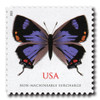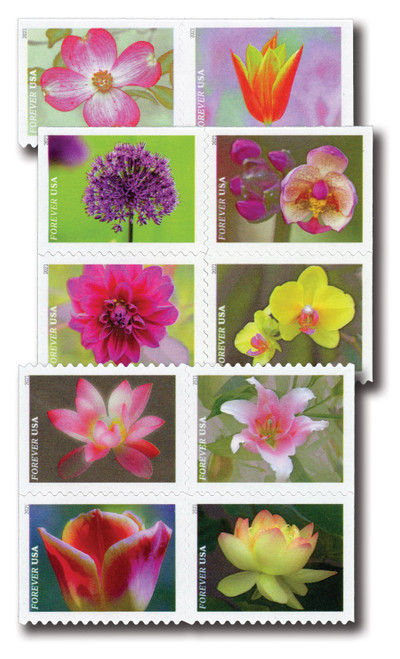
# 5568 - 2021 75c Colorado Hairstreak
US #5568
2021 Colorado Hairstreak – Non-Machinable Butterfly Series
• The 8th stamp in the Non-Machinable Butterfly series
• Pictures the colorful Colorado Hairstreak butterfly
Stamp Category: Definitive
Series: Non-Machinable Butterfly
Value: 75¢ Non-Machinable Surcharge Rate
First Day of Issue: March 9, 2021
First Day City: Estes Park, Colorado
Quantity Issued: 75,000,000
Printed by: Banknote Corporation of America
Printing Method: Offset, Microprint
Format: Panes of 20
Tagging: Phosphor, Block Tag
Why the stamp was issued: To cover the non-machinable surcharge rate and continue the Non-Machinable Butterfly stamp series.
About the stamp design: Pictures a digital image of a Colorado hairstreak butterfly created using references of preserved butterflies. Original artwork by Tom Engeman.
First Day City: The First Day of Issue Ceremony was held virtually due to the ongoing Covid-19 pandemic. The First Day of Issue Cancellation was from Estes Park, Colorado, the town known as a base for Rocky Mountain National Park. The Colorado hairstreak can be found within the park and is also the state butterfly of Colorado.
About the Non-Machinable Butterfly series: The Non-Machinable Butterfly stamp series began on May 17, 2010, with the issue of the 64¢ Monarch Butterfly design. The series was created to be used on greeting cards or other envelopes that required additional postage and/or could not be sorted on the USPS’s automated equipment (known as “non-machinable”). This may include oddly-shaped, vertical, lumpy, or rigid envelopes. Even if an envelope weighs less than one ounce but is unmachinable, it would need a non-machinable surcharge rate stamp.
The USPS worked closely with the greeting card industry on the new Butterfly series. Reflecting this close working relationship, the 64¢ Monarch Butterfly stamp was issued at the National Stationery Show in New York City. The first stamp remained in use for two years before being replaced by the Baltimore Checkerspot Butterfly design in 2012 when the non-machinable rate increased to 65¢. New stamps followed every year through 2016, with the 2015 and 2016 being the first two without the actual denominations printed on the stamps.
The California Dogface Butterfly stamp was announced in 2016 and was expected to be issued in 2017. However, the USPS held off on printing the new design until supplies of existing butterfly stamps were nearly depleted. The California Dogface Butterfly stamp was finally issued in 2019 and remained in use until March 2021, when it was replaced by the Colorado Hairstreak Butterfly stamp.
History the stamp represents: The Colorado hairstreak is a vibrant purple butterfly native to the southwestern United States and northern Mexico. It was officially declared the state insect of Colorado in 1996.
Colorado hairstreak butterflies live in mountainous shrubland and are highly dependent on the Gambel oak for survival. This tree is an important food source for Colorado hairstreak caterpillars and the adults are also often found resting among its branches. The Colorado hairstreak lays its eggs in late summer with caterpillars hatching the following spring.
Adult Colorado hairstreaks have a wingspan of one to one and a half inches with a thin tail on each back wing. This tail is what gives the species its name. Its wings are dark purple with a wide black border and orange spots on the outer edges. The underside of this butterfly’s wings are gray with white and black marks and an orange patch or small spot.
While butterfly species are often threatened by habitat loss, the Colorado hairstreak is lucky enough to still be in good standing. This is because Gambel oaks are plentiful in the regions where the butterfly is found. With continued luck, the beautiful Colorado hairstreak should be around for us to enjoy for many years to come.
US #5568
2021 Colorado Hairstreak – Non-Machinable Butterfly Series
• The 8th stamp in the Non-Machinable Butterfly series
• Pictures the colorful Colorado Hairstreak butterfly
Stamp Category: Definitive
Series: Non-Machinable Butterfly
Value: 75¢ Non-Machinable Surcharge Rate
First Day of Issue: March 9, 2021
First Day City: Estes Park, Colorado
Quantity Issued: 75,000,000
Printed by: Banknote Corporation of America
Printing Method: Offset, Microprint
Format: Panes of 20
Tagging: Phosphor, Block Tag
Why the stamp was issued: To cover the non-machinable surcharge rate and continue the Non-Machinable Butterfly stamp series.
About the stamp design: Pictures a digital image of a Colorado hairstreak butterfly created using references of preserved butterflies. Original artwork by Tom Engeman.
First Day City: The First Day of Issue Ceremony was held virtually due to the ongoing Covid-19 pandemic. The First Day of Issue Cancellation was from Estes Park, Colorado, the town known as a base for Rocky Mountain National Park. The Colorado hairstreak can be found within the park and is also the state butterfly of Colorado.
About the Non-Machinable Butterfly series: The Non-Machinable Butterfly stamp series began on May 17, 2010, with the issue of the 64¢ Monarch Butterfly design. The series was created to be used on greeting cards or other envelopes that required additional postage and/or could not be sorted on the USPS’s automated equipment (known as “non-machinable”). This may include oddly-shaped, vertical, lumpy, or rigid envelopes. Even if an envelope weighs less than one ounce but is unmachinable, it would need a non-machinable surcharge rate stamp.
The USPS worked closely with the greeting card industry on the new Butterfly series. Reflecting this close working relationship, the 64¢ Monarch Butterfly stamp was issued at the National Stationery Show in New York City. The first stamp remained in use for two years before being replaced by the Baltimore Checkerspot Butterfly design in 2012 when the non-machinable rate increased to 65¢. New stamps followed every year through 2016, with the 2015 and 2016 being the first two without the actual denominations printed on the stamps.
The California Dogface Butterfly stamp was announced in 2016 and was expected to be issued in 2017. However, the USPS held off on printing the new design until supplies of existing butterfly stamps were nearly depleted. The California Dogface Butterfly stamp was finally issued in 2019 and remained in use until March 2021, when it was replaced by the Colorado Hairstreak Butterfly stamp.
History the stamp represents: The Colorado hairstreak is a vibrant purple butterfly native to the southwestern United States and northern Mexico. It was officially declared the state insect of Colorado in 1996.
Colorado hairstreak butterflies live in mountainous shrubland and are highly dependent on the Gambel oak for survival. This tree is an important food source for Colorado hairstreak caterpillars and the adults are also often found resting among its branches. The Colorado hairstreak lays its eggs in late summer with caterpillars hatching the following spring.
Adult Colorado hairstreaks have a wingspan of one to one and a half inches with a thin tail on each back wing. This tail is what gives the species its name. Its wings are dark purple with a wide black border and orange spots on the outer edges. The underside of this butterfly’s wings are gray with white and black marks and an orange patch or small spot.
While butterfly species are often threatened by habitat loss, the Colorado hairstreak is lucky enough to still be in good standing. This is because Gambel oaks are plentiful in the regions where the butterfly is found. With continued luck, the beautiful Colorado hairstreak should be around for us to enjoy for many years to come.













